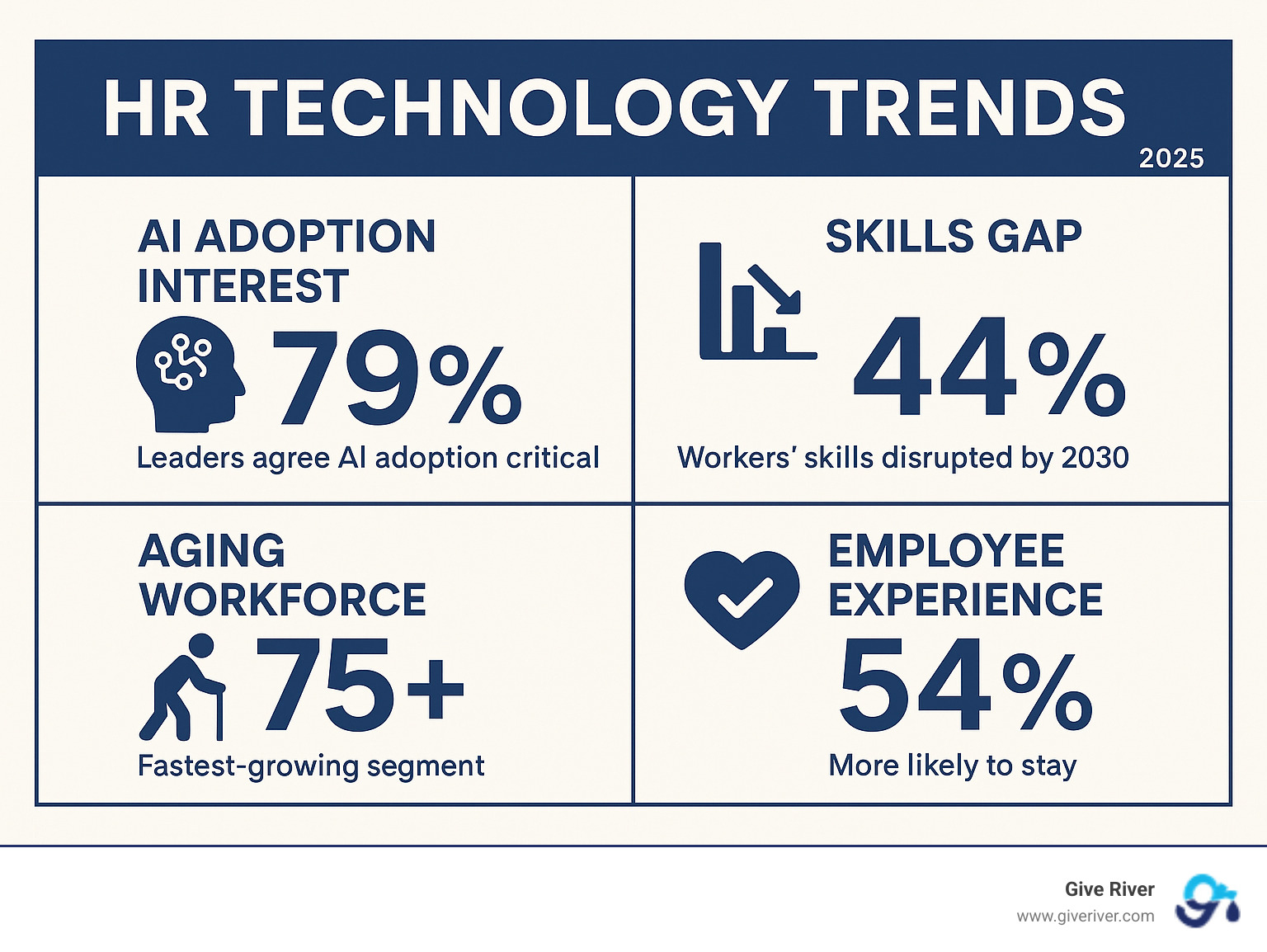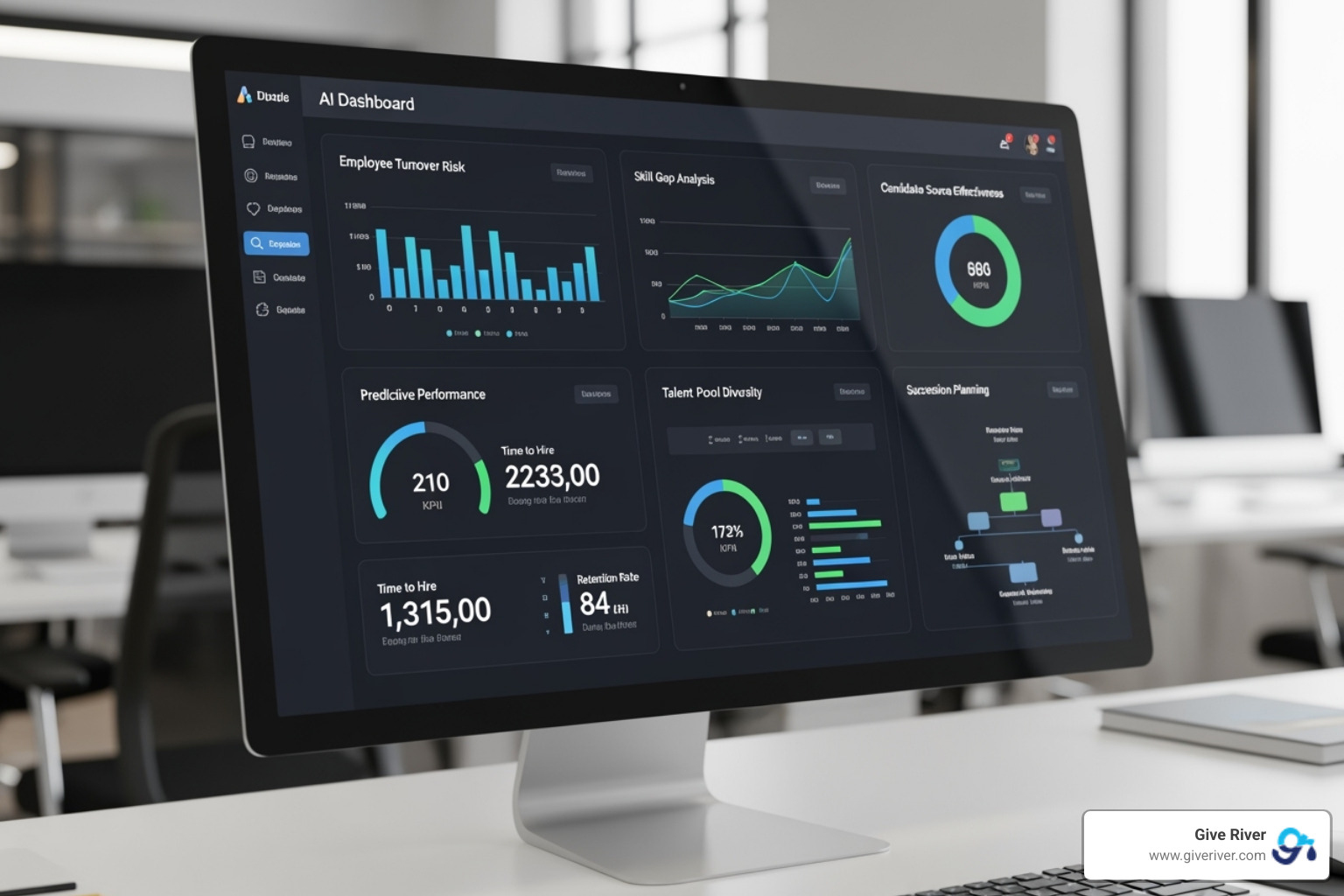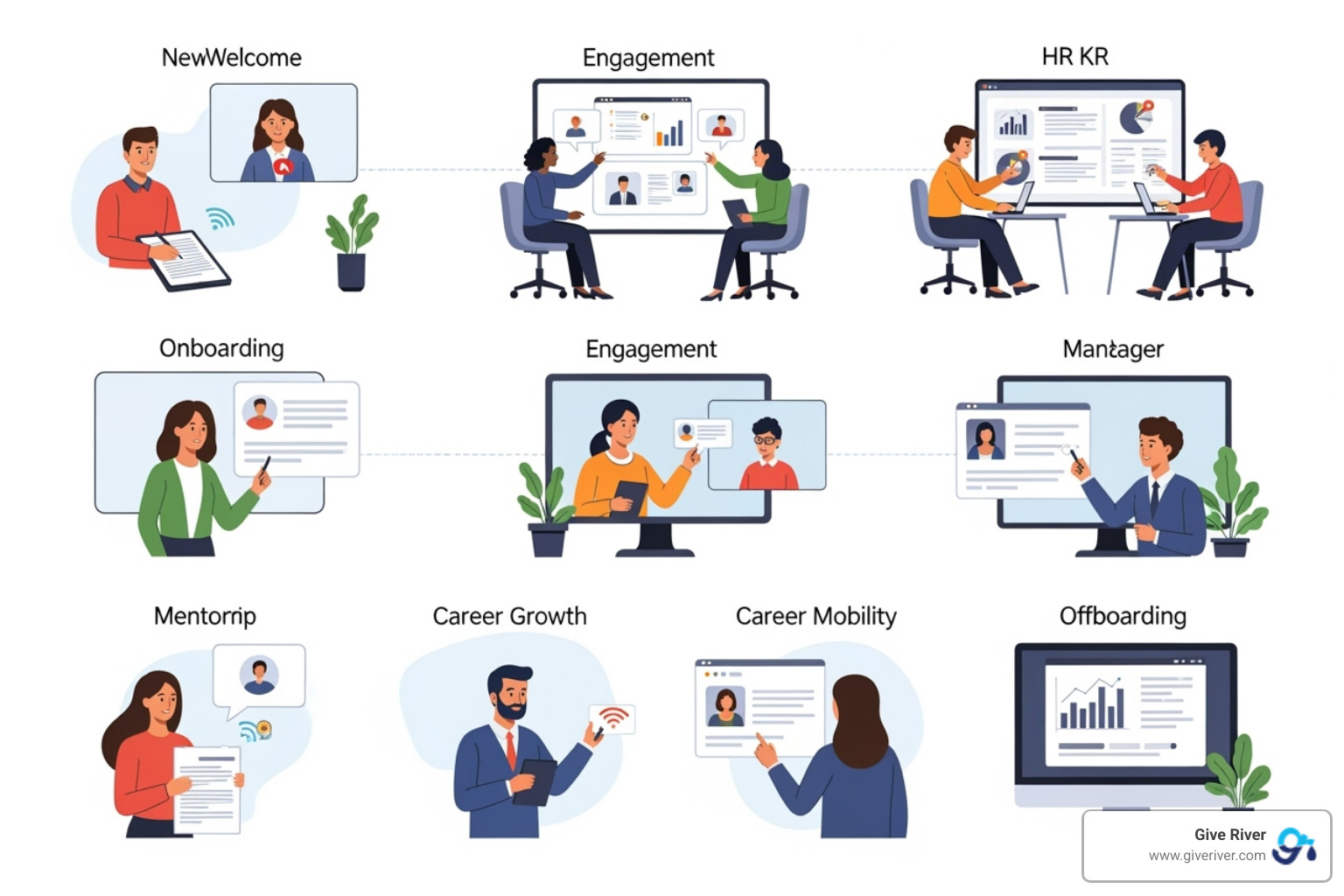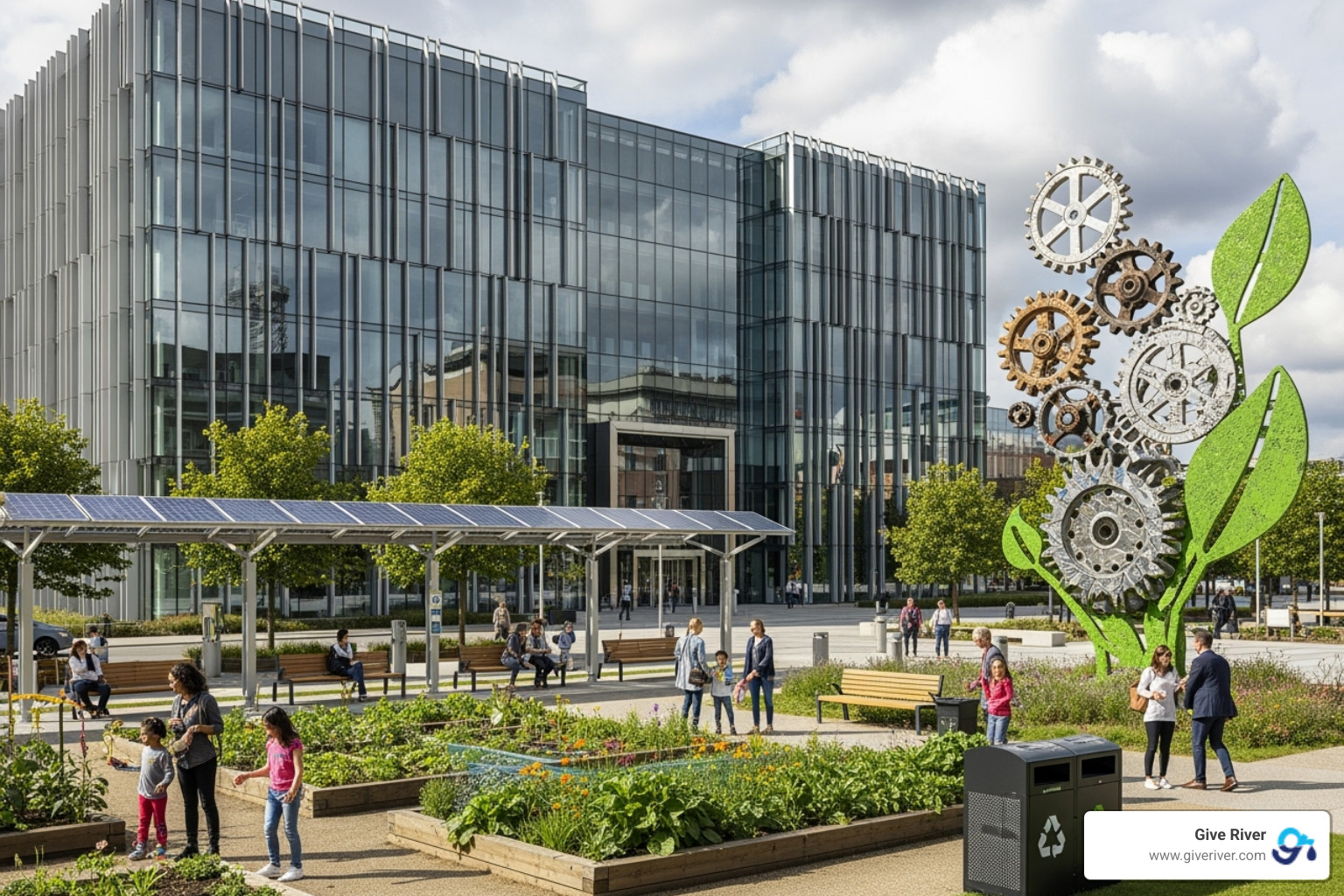Beyond Tomorrow: Your Guide to Next-Gen HR Tech Trends
Unlock the future of HR. Explore 2025's top HR technology trends, from AI to EXPs, and build your strategic tech roadmap for success.

Navigating the Next Wave of HR Innovation
The landscape of human resources is changing fast, driven by innovative HR technology trends. For HR leaders aiming to stay ahead, understanding the key forces shaping 2025 is crucial. Here are the most impactful trends:
- AI Evolution: Artificial intelligence is automating complex workflows, enhancing decision-making, and personalizing HR functions.
- Hybrid & Remote Work Enablement: Technology is essential for managing distributed teams, supporting well-being, and fostering connections across geographies.
- Skills-Based Organizations: Companies are prioritizing skills over job titles, using talent marketplaces and learning platforms to close critical gaps.
- Improved Employee Experience (EX): Integrated platforms are centralizing employee interactions, boosting engagement, and promoting holistic well-being.
- Cybersecurity & Data Privacy: Securing sensitive employee data and ensuring responsible AI governance is more critical than ever.
2025 promises transformative change, reshaping the working world. These shifts aren't just about efficiency; they're about enhancing the human experience at work. HR leaders are at the forefront of this evolution, and their strategic adoption of new technologies is vital for cultivating thriving, engaged workforces.
This guide will explore the critical trends redefining human resources, providing the insights your organization needs for future success. We'll show how HR technology trends can be leveraged to build healthier, more fulfilling work environments for everyone.

The Definitive Guide to 2025's Top HR Technology Trends
The AI Revolution: From Adoption to Responsible Strategy
Artificial intelligence is no longer a buzzword but a workplace reality. While 79% of leaders agree that AI adoption is critical to stay competitive, 60% admit their companies lack a clear plan. This gap highlights a major challenge and opportunity.
Two key forms of AI are reshaping HR: Generative AI (GenAI), which creates content like job descriptions and personalized communications, and Agentic AI, which automates complex, multi-step workflows. Despite the potential, only 12% of HR departments have adopted GenAI, and with 76% of HR professionals believing their organizations risk falling behind without it, the urgency is clear.
Forward-thinking HR teams are using AI for:
- Automation and Efficiency (77%): Streamlining tasks like resume screening and interview scheduling.
- Improved Decision-Making (43%): Using predictive analytics to anticipate workforce trends and employee turnover.
- Personalized Employee Experience (52%): Leveraging sentiment analysis, AI-powered learning, and chatbots for instant support.

However, a responsible AI strategy is non-negotiable. As many as 78% of knowledge workers use their own AI tools without official guidance, creating significant risks. HR must establish clear governance to address bias, data privacy, and ethical use. Collaborating with legal and IT, HR can create playbooks that ensure AI is used transparently and ethically. For more on this, see our guide on AI and Machine Learning in HR: Enhancing Employee Experience.
Skills-Based Organizations & The Modern Workforce
The focus is shifting from job titles to the specific skills that drive performance. This is critical, as 44% of workers' skills are expected to be disrupted by 2030, and six in ten will need retraining by 2027. While 70% of leaders believe their skills gap hurts business, few are making skills-based hires, revealing a major disconnect.
Technology is bridging this gap:
- Talent Marketplaces: Internal platforms connecting employees with projects and gigs to build new skills. Though effective, only 26% of companies use them.
- Upskilling and Reskilling Tech: Personalized training platforms and microlearning modules foster a culture of continuous learning. Our resources on Employee Development and Learning Technologies offer deeper insights.
This trend also impacts the deskless workforce, which makes up 80% of global workers but receives only 1% of software spending. Mobile-friendly HR tech designed for these roles can reduce turnover by as much as 69%. Additionally, the aging workforce—with workers 75+ as the fastest-growing segment—offers valuable mentorship. HR tech can support them with flexible work platforms and knowledge transfer systems. Business intelligence software helps map these skills, enabling data-driven talent decisions.
Enhancing the Employee Journey with Next-Gen Platforms
With 74% of companies using hybrid models, robust digital solutions are essential for connection and well-being. Employee Experience Platforms (EXPs) are becoming the central hub for the entire employee journey, from onboarding to offboarding.
The impact is clear: employees with a positive experience are 54% more likely to stay and 55% more likely to be high performers. These platforms integrate communication, engagement, performance, and learning into one cohesive experience.

Technology is also advancing Diversity, Equity, and Inclusion (DE&I). AI-powered tools can detect bias in recruitment, while inclusive learning platforms ensure equitable development. Coaching and mentoring platforms are also on the rise, fostering human connection regardless of location.
At Give River, we believe true fulfillment goes beyond basic engagement. While platforms like Bonusly and Kudos offer valuable recognition tools, they often focus on that single pillar of the employee experience. Our comprehensive 5G Method integrates recognition, guidance, wellness, gamification, and community impact. This holistic approach uses technology not just for automation, but to create supportive, thriving environments. Learn more about our approach in our guide to Employee Engagement Platforms.
Emerging HR Technology Trends: Security, Compensation, and More
As HR tech evolves, new strategic priorities are emerging.
- Cybersecurity: With remote work increasing risks, protecting sensitive employee data is an HR priority. The average US data breach now costs $4.45 million, demanding robust security features and collaboration with IT.
- Blockchain Technology: While still emerging, blockchain offers improved security and transparency. 45% of organizations are exploring it for payroll, and it holds promise for secure credential verification and employee data management.
- Compensation Management: In response to pay transparency laws, new tools help with market benchmarking, pay equity audits, and clear communication of compensation philosophies.
- Open-Source HR Solutions: These platforms are gaining traction for their adaptability, scalability, and cost-effectiveness, offering an alternative to traditional vendor lock-in.
These trends, including the continued growth of coaching platforms, underscore the need for a holistic approach to employee well-being. Our insights on The Role of Technology in Corporate Wellness Programs show how integrated solutions can support mental, physical, and financial health.
Creating Your Strategic HR Tech Roadmap for the Future
How to Stay Ahead of Evolving HR Technology Trends
Keeping up with HR technology trends requires a strategic approach, not just chasing the latest platform. Build sustainable habits to stay informed and ready.
Continuous learning is foundational. Follow industry publications from firms like Gartner and Deloitte, and attend events like the HR Technology Conference & Exposition to see solutions in action. Engaging with peers in online forums also provides invaluable, real-world insights.
Creating your strategic roadmap involves three key steps:
- Envision Your Destination: Align HR tech goals with core business outcomes. If the goal is growth, focus on tech that improves talent attraction and retention.
- Analyze Your Options: Decide between a best-of-breed portfolio or an all-in-one suite. Identify gaps in your current people, processes, and technology.
- Map Your Path Forward: Create a flexible, iterative roadmap that can adapt to new technologies and shifting business priorities.
Cross-functional collaboration is essential. Involve IT, Finance, Legal, and especially employees in the vendor selection process. Let end-users test-drive solutions with real-world scenarios to ensure the technology genuinely improves their work lives. The goal isn't just to adopt new tech, but to implement systems that improve the employee experience.
Implementing Your Vision and Driving Business Value
Implementation is more than installing software; it's about changing how your organization supports its people. Successful adoption starts with a focus on what truly drives employee fulfillment.
At Give River, we've seen that lasting change requires a comprehensive approach. For instance, while platforms like Bonusly and Kudos offer solid recognition features, they primarily address one aspect of engagement. Our 5G Method provides a more holistic experience by integrating:
- Recognition: Enabling real-time, peer-to-peer appreciation.
- Guidance: Providing personalized learning paths and mentorship.
- Personal Wellness: Supporting employees' mental, physical, and financial health.
- Gamification: Making development engaging and enjoyable.
- Community Impact: Connecting work to a greater purpose.
When these elements work together, supported by technology that delivers actionable insights, HR leaders can move from reactive to proactive. Predictive analytics can help spot turnover risks or identify burnout before they escalate. The most valuable technology makes it easier for managers to lead, employees to grow, and leaders to build a thriving culture.
When you implement HR technology with employee fulfillment as your north star, the business value follows. Engaged employees perform better, stay longer, and become your best advocates. Technology is the tool, but the real change happens when you use it to create a workplace where people genuinely want to be.
To see how analytics can open up greater fulfillment and success, explore the Power of HR Analytics Technology.




